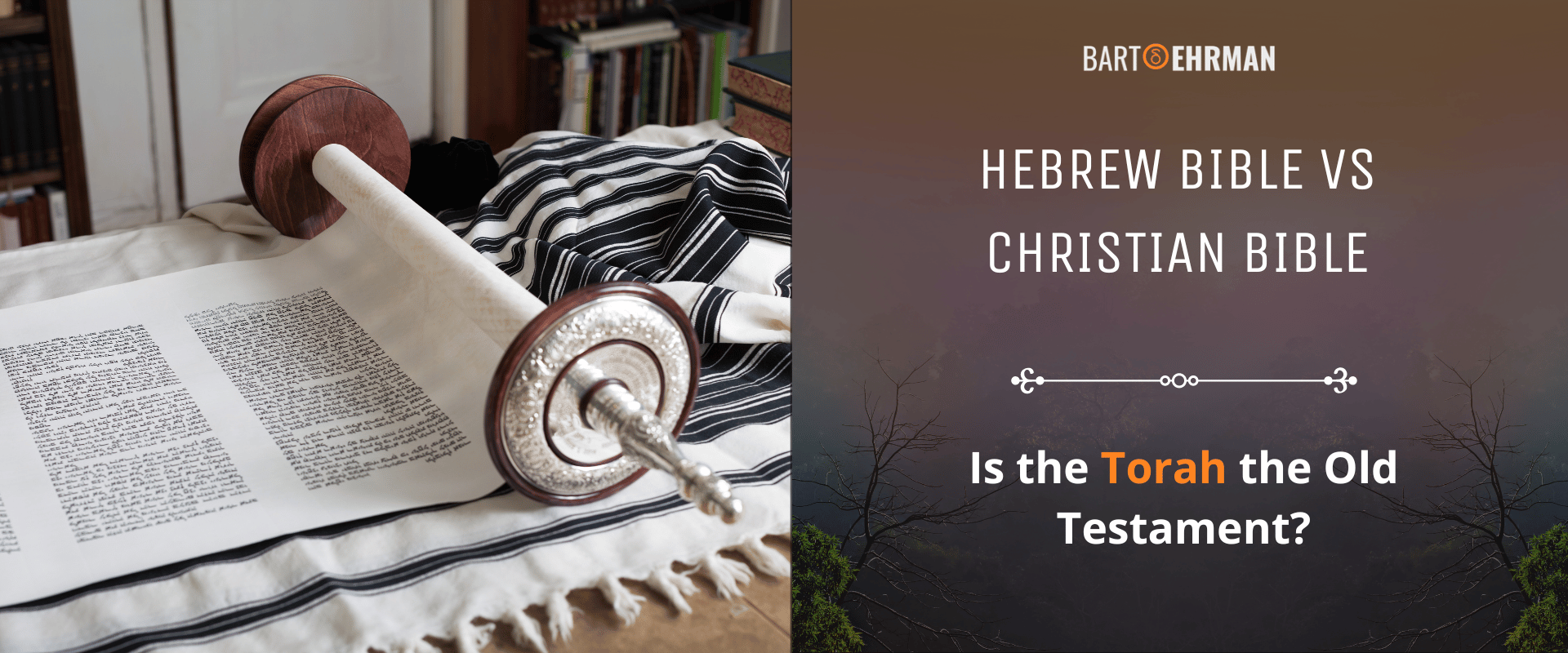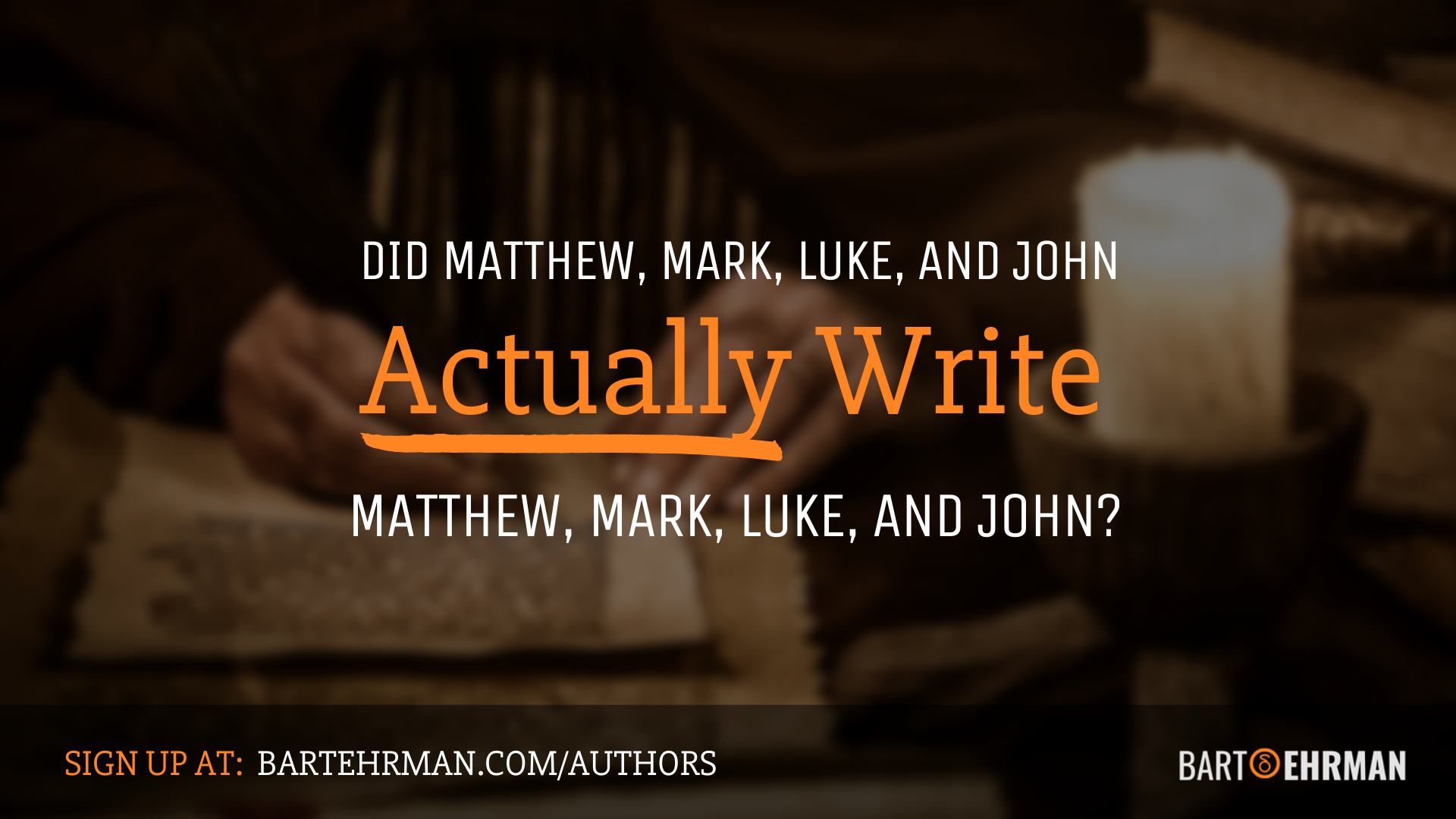Hebrew Bible vs Christian Bible: Is the Torah the Old Testament?

Written by Marko Marina, Ph.D.
Author | Historian
Author | Historian | BE Contributor
Verified! See our guidelines
Verified! See our editorial guidelines
Date written: February 22nd, 2024
Disclaimer: The views and opinions expressed in this article belong to the author and do not necessarily match my own. - Dr. Bart D. Ehrman
The intricate tapestry of history that weaves together Judaism and Christianity is marked by a complex relationship that spans centuries. This historical intertwining, while rich in shared heritage and theological foundations, hasn’t always been a narrative of cooperation and respect.
Particularly during the tumultuous periods of the Middle Ages and with the rise of Christian antisemitism, the interactions between these two faith communities were marred by conflict and violence.
This backdrop is crucial for understanding the nuances and significance of the "Hebrew Bible vs. Christian Bible" discourse, as it underscores the profound impact of these sacred texts beyond their religious content, shaping social and political landscapes throughout history.
In exploring the differences between the Hebrew Bible and the Christian Bible, it's essential to approach these texts not merely as religious canons, but as historical documents that offer insights into the evolving relationship between Jewish and Christian communities.
The Jewish Bible, or Tanakh, is revered as the foundational text of Judaism. The Christian Bible, on the other hand, incorporates the Old Testament, which shares books with the Tanakh, albeit with some important differences, alongside the New Testament, a collection of writings that chronicle the life of Jesus and the early Christian church.
Understanding this complex relationship offers a lens through which we can appreciate the depth and breadth of the cultural, historical, and theological exchanges that have shaped both traditions.

Hebrew Bible: An Introduction to Tanakh
The terminology used to refer to the sacred scriptures of Judaism and Christianity—whether called the Old Testament, the Hebrew Bible, or the Tanakh—carries layers of meaning and interpretative frameworks that extend beyond mere nomenclature. Let’s take a look at what Bible Jews traditionally use.
The most common Jewish Bible name is "Tanakh". It’s an acronym derived from the Hebrew letters of its three main sections: Torah (Teaching or Law), Nevi’im (Prophets), and Ketuvim (Writings). This designation is not just a convenient shorthand but a reflection of the Jewish tradition’s holistic view of its sacred texts, emphasizing their interconnectedness and the breadth of their religious, moral, and cultural teachings.
The Torah, or the Five Books of Moses, lays the foundational narratives and laws that have shaped Jewish identity, religious practice, and ethical conduct.
Following the Torah, the Nevi’im section encompasses both the historical accounts of figures like Joshua and Samuel and the larger-than-life prophecies of Isaiah, Jeremiah, and others, who spoke to their contemporaries while also addressing themes of justice, repentance, and redemption that resonate universally.
The Ketuvim, or Writings, include a diverse collection of texts ranging from the poetic and introspective Psalms to the wisdom literature of Proverbs and the narrative richness of books like Ruth and Daniel.
But, it’s important to note that there is more than one canon of texts within the Judaic history. As Paul Johnson notes: “The Samaritans, having been cut off from Judah in the middle of the first millennium BC, preserved only the five Mosaic books since they were not allowed to take part in the canonization of later writings, and therefore did not recognize them.”
Understanding the structure and content of the Tanakh is crucial for appreciating its role within Judaism and its influence on the development of the Christian Bible. The Christian designation of these texts as the "Old Testament" reflects the belief in a new covenant established through Jesus Christ, as narrated in the New Testament.
This perspective introduces a distinct interpretative lens through which the shared scriptures are viewed, often emphasizing prophetic fulfillment and typological readings that point to the Christian faith.
However, it's important to recognize that the Jewish understanding of the Tanakh remains rooted in its original context, celebrating the covenant between God and Israel, the richness of its laws, and the depth of its narratives and poetry. Finally, navigating the complexities of the "Hebrew Bible vs. Christian Bible" involves understanding the distinct theological and cultural lenses through which they are interpreted.
Having explored the structure and significance of the Tanakh, we now turn our focus to the Christian Old Testament, delving into its formation, content, and how it distinguishes itself from the Jewish Bible or Tanakh.
Christian Bible: The Old Testament
In the formative period of what would later become Christianity, Jesus and his earliest followers were deeply rooted in the Jewish tradition, sharing the Hebrew Bible as their sacred scripture. This foundational text provided the theological and ethical groundwork for their beliefs and practices.
Given this shared heritage, it was only natural for these early Jewish followers of Jesus to accept the Jewish Bible as their scripture. Is the Torah the Old Testament? It’s an essential part of the Old Testament for all Christians today. However, how Christians interpret both the Torah and Hebrew Bible in general marks a significant departure from mainstream Jewish thought.
This divergence in interpretation laid the groundwork for developing distinct religious identities and parting of the ways between Judaism and Christianity; between the Hebrew Bible and the Christian Bible.
The adoption of the Scripture of Judaism by early Christians wasn’t merely a matter of accepting an existing corpus of texts; it involved a re-interpretation of these texts through the lens of Jesus' life, teachings, and, significantly, his death and resurrection.
One of the pivotal moments in this process of adoption and reinterpretation was the early Christian use of the Septuagint, a Greek translation of the Hebrew Bible. The Septuagint made the Jewish scriptures accessible to non-Hebrew-speaking believers.
The translation itself, with its nuances and differences from the original Hebrew, played a role in shaping early Christian interpretations of scripture. For example, certain passages in the Septuagint were read as prophesying Christ's coming and mission more clearly or differently than their Hebrew counterparts, further distinguishing Christian use and understanding of these sacred texts.
A quintessential example of the interpretive divergence between early Christianity and mainstream Judaism can be found in the Gospel of Matthew's quotation from Isaiah regarding the birth of Jesus. Matthew's narrative employs the Septuagint version of Isaiah 7:14, which uses the Greek term παρθένος (parthenos), to prophesy the virgin birth of Jesus.
This choice is significant because the Hebrew text of Isaiah employs the term "עלמה" (almah), a word that only denotes a young woman of marriageable age. Additionally, the origins and historical context of Isaiah 7:14 have nothing to do with the virgin birth of the future Messiah - as Raymond Brown has shown in his detailed analysis.
This complex process of accepting, interpreting, and sometimes re-envisioning the Hebrew Bible laid the foundation for what would eventually be recognized as the Christian Old Testament. But what is the difference between the Hebrew Bible and the Old Testament? Let’s get a closer look at the “Hebrew Bible vs. Christian Bible” discussion.
Hebrew Bible vs. Christian Bible: Understanding Differences
John J. Collins aptly remarked: “The Christian Old Testament is so called in contrast to the New Testament, with the implication that the Old Testament is in some sense superseded by the New.” This observation underscores a critical aspect of Christian religious tradition.
The Old Testament, despite being seen as preparatory and foundational to the New Testament, remained a vital component of the Christian canon. Additionally, the Christian Old Testament not only serves as a historical and theological backdrop for the New Testament but also continues to be revered as sacred scripture, contributing to the richness of Christian spiritual life.
However, it’s important to recognize that there are significant differences between the Christian Old Testament and the Hebrew Bible or Tanakh. Differences that go beyond mere nomenclature.
#1 The structure of the text
The Christian (Protestant) Old Testament has the same content as the Hebrew Bible but it structurally differs from that of the Tanakh. The Christian canon typically organizes the books into four main categories: the Pentateuch (Torah), Historical Books, Wisdom Books, and Prophets. This organization contrasts with the Tanakh’s division into Torah, Nevi'im, and Ketuvim.
In the Protestant Old Testament, the texts of Samuel, Kings, Ezra-Nehemiah, and Chronicles are each divided into two separate books, and the Minor Prophets are enumerated as twelve distinct books, culminating in a total of thirty-nine books.
Additionally, the former prophets are categorized as historical books and are grouped with Chronicles and Ezra-Nehemiah. Contrarily, Daniel is classified under the category of prophetic literature. The arrangement of the Latter Prophets is adjusted to appear at the end of the canon, serving to create a thematic bridge that anticipates the advent of the New Testament.
#2 Additional books within the Old Testament
Bart Ehrman notes that “even within Christianity there are different numbers of books included in the Old Testament”. In contrast to the Protestant tradition, the Catholic and Greek Orthodox churches include books in their Old Testament that aren’t found in the Jewish Bible. They are known as the Deuterocanonical books:
It seems, after two millennia, Christians still engage in a spirited debate over the exact composition of their Bible - almost as if they were participants in a never-ending book club struggling to agree on the next month's reading list.
The presence of these additional books in the Catholic and Orthodox canons, but not in the Protestant or Hebrew Bible, emphasizes the complexity of scriptural tradition within Christianity. It reflects the historical processes of canon formation, which were influenced by various factors, including theological disputes and the decisions of church councils.
However, the distinctions in the "Hebrew Bible vs. Christian Bible" debate extend beyond mere content and structural variations. Indeed, Christianity and Judaism exhibit significant differences in their interpretative approaches to these sacred texts, underscoring a deeper layer of divergence in theological perspectives and hermeneutical traditions.

The difference between the Hebrew Bible and the Old Testament: Interpretation, Perspective, and Approach
Given the distinct foundations and evolutions of Judaism and Christianity as separate religious traditions, it’s natural to encounter differing approaches and interpretations of shared scriptures. These variations reflect deeper theological and philosophical underpinnings that distinguish each religion.
One of the most prominent examples of interpretative variation concerns the Christian reading of the Old Testament as containing prophecies about Jesus and his fulfillment of these prophecies. For instance, Christians interpret the prophecy in Micah 5:2, which speaks of Bethlehem as the birthplace of a future ruler of Israel, as a clear reference to Jesus' birthplace.
Similarly, the "Suffering Servant" passages in Isaiah 53, with verses like "But he was pierced for our transgressions, he was crushed for our iniquities," are seen by Christians as foretelling Jesus' sacrificial death for humanity's sins.
However, it's important to note that most critical scholars recognize the original context of Isaiah 53 as not directly referring to the Messiah. Bart Ehrman explains: “In no source before the writing of the New Testament is there any reference to a future Messiah who is to suffer and die for the sins of the people.” If you want to know what the original context and meaning of Isaiah 53 is, check out Dr. Ehrman’s article!
Another stark difference in interpretation between the two traditions revolves around the concept of original sin. In Christianity, the narrative of human disobedience in the Garden of Eden, as depicted in the Torah (Genesis), has been understood to mark all humanity with the stain of original sin.
This theological concept, developed first by the Apostle Paul, posits that the act of eating from the fruit of the Tree of Knowledge introduced a fundamental brokenness into human nature, a condition that every person inherits and that Jesus came to atone for.
St. Augustine, for instance, argued that the ordered desire is longing to obey the commands of God, which leads to flourishing, but failing to desire obedience to God’s commands leads to sin and sickness. In other words, the disobedience was, for Augustine, central to the original sin.
In stark contrast, such a concept of original sin is absent from Jewish theology. For instance, the story of Cain and Abel in Genesis 4 highlights a different perspective: God tells Cain that although he tends to be evil, he can master it.
Furthermore, Samuel S. Cohon notes that the rabbinic tradition which became the most dominant form of Judaism after the fall of the Temple in 135 C.E. developed the idea that all sin is the result of man’s own action. Therefore, the sin per se isn’t casually related to the mistake Adam and Eve made in the Garden of Eden.
This difference underscores a fundamental theological divergence: Christianity sees Jesus' sacrificial death as central to atoning for original sin, whereas Judaism which rejects the belief in Jesus’ messianic identity doesn’t articulate a concept of humanity perpetually tainted by the sins of the first humans.
Christian Bible: The Emergence of the New Testament
Undoubtedly, the most significant distinction in the "Hebrew Bible vs. Christian Bible" discourse lies in the Christian tradition's inclusion of an entirely new set of writings known as the New Testament.
This collection of books, originally written in Koine Greek, isn’t merely an addition but represents a profound expansion of the scriptural canon, introducing the teachings, life, death, and resurrection of Jesus Christ as the cornerstone of the Christian faith.
The New Testament encompasses the Gospels, which recount the life and teachings of Jesus; the Acts of the Apostles, which detail the early church's formation; the Epistles, letters offering theological and moral guidance; and the Book of Revelation, revealing visions of the end times.
The emergence of the New Testament was a gradual process, deeply intertwined with the life of Jesus and the subsequent spread of his teachings by his followers.
Significantly, some of Paul's epistles were recognized as authoritative within Christian communities by the end of the 1st century, marking the beginning of the New Testament canon formation.
The author of 2 Peter refers to false teachers who misinterpret the “letters of Paul”. Interestingly enough, he then proceeds to conclude “just as they do with the rest of the Scripture (2 Pet 3:16).” As Bart Ehrman observes: “Evidently, this unknown Christian author took Paul’s letters to be Scripture.”
By the end of the 3rd century, the proto-orthodox Church (a stream of Christianity that eventually triumphed over other Christian communities in the Roman Empire) had reached a consensus on the core books of the New Testament: the four Gospels, the Acts of the Apostles, and thirteen of Paul's epistles.
This agreement was pivotal in defining the boundaries of Christian Scripture and shaping the theological and ecclesiastical identity of early Christianity.
The inclusion of the New Testament in the Christian canon represents a theological and historical bridge from the covenantal traditions of the Jewish Bible or Tanakh to the new covenant proclaimed by Jesus Christ.
This canonization process reflects the early Christian community's efforts to define their beliefs, preserve the teachings of Jesus and his apostles, and distinguish their faith from both Judaism and other emerging Christian interpretations.
Conclusion
As we conclude our exploration into the nuanced discourse of the “Hebrew Bible vs. Christian Bible”, it becomes evident that these important collections of texts, while sharing a historical and spiritual lineage, unfold into distinct narratives that have shaped the identities of Judaism and Christianity.
The Torah, with its foundational narratives and laws, has not only sculpted the moral and cultural framework of Jewish life but has also served as a critical point of departure for the Christian Old Testament, which, through its reinterpretation of shared scriptures, seeks to illuminate the life and teachings of Jesus Christ as fulfilling ancient prophecies.
The emergence of the New Testament as a cornerstone of Christian scripture introduces a profound expansion of the biblical canon, emphasizing the new covenant and underscoring the divergent paths these two faiths have taken from their common ground.
This divergence isn’t merely in the additional texts but also in the interpretive lenses through which each tradition views the scriptures, from prophetic fulfillments concerning Jesus to the foundational theological differences such as the concept of original sin.
Thus, the "Hebrew Bible vs. Christian Bible" discourse isn’t just a comparison of texts but a reflection of the dynamic and evolving relationship between two of the world's major religions, each offering a rich tapestry of wisdom, narrative, and law that continues to inspire, challenge, and shape the human experience.
For those intrigued by the intricate interplay of history, legend, and myth within the Hebrew Bible or Tanakh, the journey doesn’t end here. Delve deeper into the fascinating origins and interpretations of biblical texts with "In the Beginning: History, Legend, and Myth in Genesis," a course led by renowned scholar Dr. Bart D. Ehrman.
This course offers an unparalleled opportunity to explore the Book of Genesis through a scholarly lens, examining the fine line between historical events and mythological narratives. Whether you're a student of religion, or history, or simply a seeker of knowledge, this course promises to enrich your understanding of one of the most influential texts in human history.

